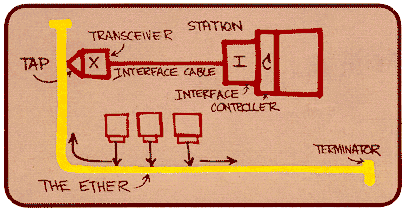The origin of the Ethernet symbol
By stretch | Thursday, May 29, 2008 at 11:10 a.m. UTC
Ethernet recently turned 35, and it struck me as amusing that its original icon is still prolific in so many network diagrams. Pictured below is one of the first drawings of an Ethernet segment by Bob Metcalfe, courtesy of Charles Spurgeon's Ethernet website.

Indeed, the original Ethernet implemented a shared coaxial cable (thicknet), which end hosts connected to via vampire taps. Hence the half-duplex bus. I'm too young to have had the [mis]fortune of working with original Ethernet myself, but its progression over the decades has always fascinated me.
You'd think that such a concept would be long forgotten in the realm of modern local area networks, those which employ full-duplex switching at speeds exponentially faster than their predecessors. Yet, the symbolism lives on: the following stencil comes stock with Microsoft Visio 2007.

If you're interested as I am in how Ethernet functions, check out Ethernet: The Definitive Guide by Charles Spurgeon.
Posted in Random
Comments
April 24, 2013 at 5:14 p.m. UTC
I am (unfortunately) old enough to have enjoyed the pleasure of tripping over ThickNet coax laying all over the floor, connecting our Ultrix workstations; circa 1990 while at WilTel in Tulsa. That, and having vampire taps constantly failing after being stepped on or kicked.
and then there were the Good Old Days of ArcNET...
